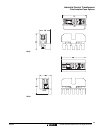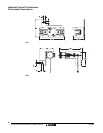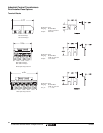
Industrial Control Transformers
Frequently Asked Questions
58
© 1999–2005 Schneider Electric All Rights Reserved 08/2005
FREQUENTLY ASKED QUESTIONS
Question Answer
Should you consolidate your control
transformer to a MultiTap or Universal
Control Transformer?
When A Multitap Unit Might Be For You:
1. Transformer will be installed in a device whose source voltage is unknown at time of shipment
2. Space is not critical (MultiTaps are larger than standard units)
3. You sell to markets with multiple source voltages
4. Reduced number of parts will offset premium for MultiTap units
When A MultiTap Unit Might Not Be Beneficial
1. High percentage of your business is 240 x 480 source voltage
2. Space is an issue
3. Source voltage is always known at time of shipment
4. Source voltage changes other components in the control circuit
5. Premium for MultiTap does not get offset by having fewer parts
Can a 9070 type T or TF control transformer
be used in a back (reverse) feed application
as a step-up transformer?
No, they cannot. Industrial control transformers terminals are specifically marked “primary” and ”secondary”. As such,
the National Electrical Code (NEC) and Underwriters Laboratories (UL) prohibit connecting the source to other than
the primary terminals. Also, since industrial control transformers utilize compensated windings to accomodate the high
regulation inherent in such small transformers, the resulting voltage ratio would be lower than desired. In other words,
if a control transformer were reverse fed, the output voltage would be lower than desired.
Does Schneider Electric provide fuses for the
primary and the secondary of a 9070 Type TF
industrial control transformer?
While the 9070 Type TF industrial control transformer comes with a three-pole fuse block (two rejection type Class CC
fuses for the primary, and one non-rejection type midget fuse for the secondary), Schneider Electric does not provide
the fuses. Proper fuse selection is the installer’s responsibility and is dictated by NEC table 450-3(b) and any specific
application parameters that exist with any industrial control transformer installation.
My 9070 Type T or TF industrial control
transformer has four terminals on both the
primary and secondary, but only markings on
the wiring diagram of H1and H2 on the
primary and X1 and X2 on the secondary.
Which terminal do I use?
The nameplate of your Schneider Electric 9070 Type T or TF industrial control transformer clearly marks out that the
outside terminals of each side are used for the customer installed wire connections. Schneider Electric makes a
standard four- or six-terminal block for various transformer designs for commercial cost effectiveness. With only two
terminals being used, it is standard practice for it to always be the outside terminals. Several different transformer
voltage and wiring arrangements are shown in this catalog.
How do the 9070-FB3A, 9070-FB2A, and
9070-FB-1A fuse blocks mount on a 9070
Type T control transformer when factory
installed? When field installed?
When factory installed on a 9070 Type TF control transformer, they mount on the center of the core on factory
installed studs. When field installed by the customer on a 9070 Type T control transformer, they mount over one of the
terminal strips using hardware supplied with the fuse block kit. (There are no studs on the 9070 Type T, only on the
Type TF.)
Does Schneider Electric offer epoxy
encapsulated versions of its 9070 Type T and
TF control power transformers?
Schneider Electric does not offer epoxy encapsulated industrial control transformers. The 9070 Type T and TF
industrial control transformer is the premier offering in the industry and is suitable for virtually any installation
appropriate for a CPT.
What is the sound level for a 9070 Type T
control transformer?
Sound levels for general purpose and control transformers are per NEMA ST-20 sound levels. For Type T control
transformers, this level is 40dB maximum.
Are replacement jumper kits offered for
Schneider Electric’s 9070 Type T and TF
industrial control transformers?
Yes. Replacement jumper kits contain two jumpers per kit and must be ordered in minimum quantities of 50 kits.
Use kit number 30033-027-53 for Accessory Key I (25–200 VA) and Accessory Key II (25–150 VA).
Use kit number 30033-027-54 for Accessory Key I (250–5000 VA), Accessory Key II (200–3000 VA), and Accessory
Key III ( 25–3000 VA).
Do 9070 industrial control transformers
contain any materials, such as PCBs, lead, or
other heavy metals, that would require
special disposal means
Schneider Electric 9070 Type T and TF industrial control transformers do not contain any material that would require
any special disposal means and can be disposed of in the normal manner. Since the majority of the transformer is built
of recyclable material (steel, copper, etc.), Schneider Electric urges the customer to recycle the unit if possible.
What does a “triple rating” mean in terms of
an industrial control transformers voltage
code?
A triple rating on the control transformer`s voltage code basically means that the transformer is designed to
successfully operate at voltages slightly different than the nominal voltage at its full VA capacity. This is done to allow
for different voltage systems that require the same voltage ratios, say 4:1 or 2:1.
Example: The 9070T250D1 is a triple rated voltage code unit that can supply 250VA with the following input voltages
and the corresponding output:
Input: 240 or 480 Output: 120
Input: 230 or 460 Output: 115
Input: 220 or 440 Output: 110
What is the maximum fuse ampere rating that
can be used in a factory or field installed fuse
block or fuse clip for a 9070 Type T control
transformer?
The maximum ampere rating of the fuse blocks and fuse clips offered by Schneider Electric for the 9070 Type T
control transformers is 30 amps. If higher fuse ratings are required, then the customer will have to provide the
supplementary fuse holder provisions.
On a 9070 Type T or TF industrial control
transformer with more than one secondary
voltage available, can more than one
secondary voltage be utilized or only one?
The capabilities of the various 9070 Type T and TF tranformers vary widely. Some units can only have one voltage out
with a given voltage in. Others can have more than one. Contact your Schneider Electric representative for
assistance.
If a satisfactory model is not available, Schneider Electric has the capability of building virtually any industrial control
transformer a customer may need.


















